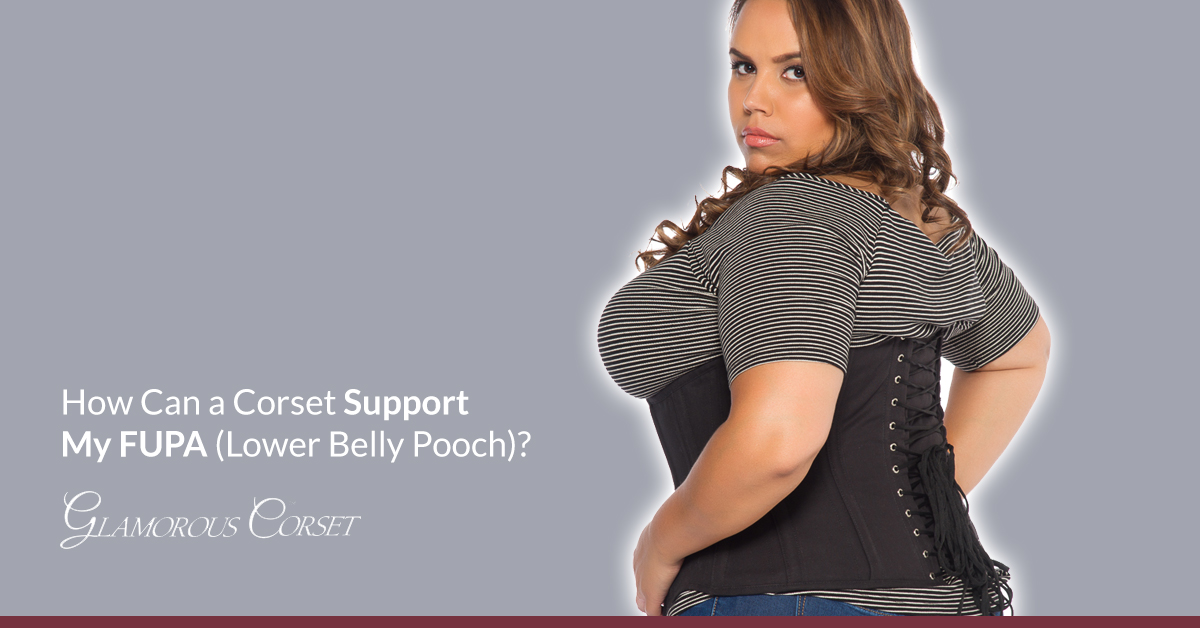Blog
How Can a Corset Support My FUPA (Lower Belly Pooch)?
Featured Corset: Lara Black Cotton Corset (Plus Size)
When low-rise jeans became the de facto style some years ago, many a curvy lady suffered the difficulties of managing a muffin top.
Not only is it normal to develop a tummy pooch as we age and our bodies naturally deposit fat around the midsection, but if you’ve stretched your belly in service of bringing children into the world, it’s not unusual to find yourself dealing with a FUPA.
What is a FUPA? Can it be controlled with a corset, or will this garment make it more visible and pronounced? Here’s what you need to know about the interplay between body and compression garment to make the corsets in your wardrobe work for you.
What Is a FUPA?
FUPA is an acronym that stands for “fat upper pubic area.” It’s also called a panniculus. In essence, it’s the poochy area of your lower belly that sits above the pubic bone and causes your underwear to roll down every time you sit or bend over. Hey, girl, we’ve all been there.
In some cases, a FUPA is hereditary. It might be related to age, weight gain or loss, childbirth, or a range of other contributing factors. Unfortunately, diet and exercise may not be sufficient to get rid of a FUPA, as targeting this area is extremely difficult.
Some women go so far as to get cosmetic surgery like lipo or a tummy tuck to rid themselves of a FUPA, but many women simply accept it as part of aging or having kids and find ways to camouflage it.
The right mid-rise or high-waisted pant can help you control this area, as can supportive undergarments like belly-taming panties or shorts, or control-top nylons.
What if you’re interested in waist training, though? Can a corset hide your FUPA, or will it make the problem worse?
How a Corset Can Help
Like many types of compression garments, corsets can help camouflage areas of your midsection that are a little poochy. However, there’s a caveat when it comes to the FUPA. If you choose the wrong corset style, it could actually exacerbate your problem.
A shorter corset style, such as an underbust or waspie model that doesn’t extend down to the hip or has a straight lower edge, could end up pushing your belly downward, creating a more defined FUPA. This really won’t do.
How can you avoid this fashion catastrophe? You could pair your corset with a secondary compression garment like underwear, shorts, or even high-waisted jeans. Or you could opt for a corset that covers the area more completely, such as a longline model or a garment that features a downward curve in the front to cover the belly.
Customizing Your Corset
If you’re having trouble finding an off-the-rack corset that works for your body, you could always consider a custom-made garment. However, these can be quite costly.
The other option is to look for a curved busk designed to accommodate a bit of a belly pooch. Sadly, these are difficult to find, as most busks are manufactured straight to flatten the stomach.
That leaves you to bend busks on your own. If you think you’ll want a curved front, try to purchase corsets that have more flexible busks.
Ideally, you’ll attach the busks and bend them at the same time, using your hands. If this is too hard, you can bend them separately, but it will take some time to match them up as you go. Focus your bends between brackets (pegs and loops) so as not to damage these essential closures.
To create space for a FUPA, you’ll want a convex (outward) curve in the lower belly area. This will help hold your tummy in place instead of pushing it out the bottom of the garment. Make sure to try it on as you go to ensure the best contour for your physique.
To stay up-to-date with weekly blog posts, waist training tips, and the chance to win one of our monthly corset giveaways, follow us on Facebook, Instagram & subscribe to our mailing list today! Want to find the perfect steel boned corset? Shop some of our favorites: underbust corsets, overbust corsets, corset dresses. You can also shop our corsets by material: cotton corsets, denim corsets, leather corsets, mesh corsets, pvc corsets, and satin corsets. Have questions about getting started with waist training or finding the right size corset? Contact us!

My name is Rachel, I am the owner of Glamorous Corset, a small business founded by me in 2010. Back In 2005, I was in a car accident that left me with a herniated disk. Much to my surprise I learned steel boned corsets were beneficial to several medical injuries including mine. I was always intrigued with corsetry, their history and their beautiful aesthetic. I love sharing knowledge about corsets, educating my wonderful readers and breaking the negative stigma related to corsetry. In combination with my years of research and personal experience I hope my articles are useful and can help anyone who has struggled with some of the same things I have. More about me…


